by Bruce Wells | May 19, 2025 | Petroleum Pioneers
Oilfield discovered in May 1940 — after 57 years of unsuccessful searches for a “vein of petroleum.”
Pawnee Royalty Company completed a successful wildcat oil well in Nebraska’s Richardson County on May 1940, after lawmakers in Lincoln, eager for petroleum tax revenue, offered a $15,000 bounty.
After more than a hal-century of drilling expensive “dry holes,” Nebraska’s first commercial oil well arrived on May 29, 1940, in the far southeastern corner of the state. The Pawnee Royalty Company made the discovery west of Falls City. The company had drilled two unsuccessful wells near Falls City in 1939.
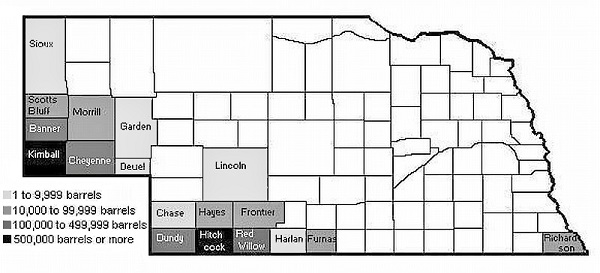
Nebraska’s oil production reached more than 2.51 million barrels of oil in 2012 (above), but declined to about 1.71 million barrels of oil by 2021, according to the Nebraska Oil and Gas Conservation Commission.
A historical marker in Richardson County reports the earliest “publicized report of oil in Nebraska had been an 1883 newspaper account of a ‘vein of petroleum’ discovered in the same county.”
“Over the next 57 years the search for oil consumed thousands of dollars, and hundreds of wells were drilled throughout Nebraska,” adds the marker, erected by the Nebraska Petroleum Council. “Traces of oil were reported at various locations across the state, but Nebraska did not have a producing well until 1940.”
Oil Discovery Bounty
Eager to become an oil-producing state, the Nebraska legislature had offered a $15,000 bonus for any oil well in Nebraska to produce 50 barrels daily for 60 consecutive days. Florida lawmakers, also eager for oil revenue, would do the same (see First Florida Oil Well).
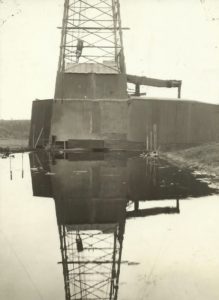
Circa 1940s postcard depicts a “pool of oil” produced by the Bucholz Well No. 1 near Falls City, Nebraska.
Although unsuccessful, the two earlier Pawnee Royalty Company wells had shown encouraging signs near Falls City. A third well, Bucholz No. 1, began drilling on April 22, 1940.
“On May 29, 1940, the well began producing and averaged 169-1/2 barrels daily for the first 60 days,” notes the historic marker. “Bucholz Well No. 1 thus easily qualified for a $15,000 bonus.”
Richardson County enjoyed a drilling boom for three years. The state’s first successful oil well was completed five miles east of the county’s “vein of petroleum” first reported in 1883.
SW Nebraska Oilfields
More Nebraska petroleum production would come from the southwestern panhandle. A 1949 discovery well produced 225 barrels of oil a day from a depth of 4,429 feet. Marathon Oil completed the well, the Mary Egging No. 1, five miles southeast of Gurley in Cheyenne County.

The Marathon oil discovery in western Nebraska ended 60 years of drilling expensive “dry holes” in that part of the state, according to a roadside marker on U.S. 385 between Sidney and Gurley.
According to the marker, interest in finding oil in western Nebraska began in 1889, near Crawford, in the northwest corner of the Nebraska Panhandle, and “drilling there took place in 1903 near Chadron, also in the northern part of the Panhandle.”
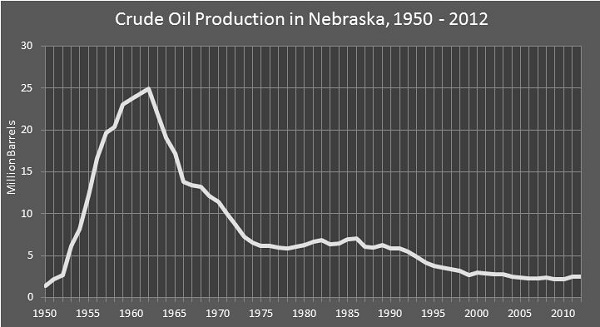
Prior to 1950, Nebraska had no office to report production for record keeping. Oil production from 1939 to 1949 is estimated by the Geological Survey to have been almost six million barrels.
A 1917 exploratory well, “drilled in the southwest Panhandle, near Harrisburg, failed,” the marker adds. “Oil searchers sunk many other dry test wells in western Nebraska until success came in 1949.”
New Technologies
By 1966, wells in the western Nebraska oilfields produced more than 216 million barrels of oil. “The pioneer efforts in this area have resulted in a major contribution to the economy of the state,” concludes the Nebraska State Historical Society.

New technologies, including horizontal drilling and hydraulic fracturing, brought renewed activity to Nebraska in the 2000s. Exploration company geologists began testing the Niobrara Shale in the southwestern part of the state.
Nebraska’s annual production declined in 2023 to about 1.5 million barrels of oil, which was the lowest level since 1950, according to the Energy Information Administration (EIA). Production peaked in 1962 at almost 25 million barrels.
Learn about the earliest oilfield discoveries in other petroleum-producing states in First Oil Discoveries.
_______________________________
The American Oil & Gas Historical Society (AOGHS) preserves U.S. petroleum history. Please become an AOGHS annual supporter and help maintain this energy education website and expand historical research. For more information, contact bawells@aoghs.org. © 2025 Bruce A. Wells.
Citation Information – Article Title: “First Nebraska Oil Well.” Author: Aoghs.org Editors. Website Name: American Oil & Gas Historical Society. URL:https://aoghs.org/petroleum-pioneers/first-nebraska-oil-well. Last Updated: May 23, 2025. Original Published Date: May 26, 2013.
by Bruce Wells | May 17, 2025 | Petroleum Pioneers
West Texas discoveries in the 1920s revealed a petroleum expanse 250 miles wide and 300 miles long.
A West Texas oil well blessed by nuns revealed the true size of the petroleum-rich Permian Basin in 1923. A small university in Austin owned the arid land, which had been deemed mostly worthless by experts.
Successful exploration of the Permian Basin, once known as a “petroleum graveyard,” began in February 1920 with a discovery by William H. Abrams in Mitchell County in West Texas. When completed after “shooting” the well with nitroglycerin in July, production averaged 20 barrels of oil a day.

In 1958, the University of Texas moved the Santa Rita No. 1 well’s walking beam and other equipment to the Austin campus. The student newspaper described the well, “as one that made the difference between pine-shack classrooms and modern buildings.” Photo from 2007 by Bruce Wells.
The W.H. Abrams No. 1 oilfield discovery well of the Permian Basin would lead to the area’s first commercial oil pipeline in the Permian Basin, according to a Texas Historical Commission historic marker placed near the well in 1996 (reported missing in 2020).
Meanwhile, even with its limited production, the Abrams well began attracting oil exploration to the barren region.
West Texas Oil
It would be another Permian Basin discovery well that launched a stampede of wildcatters to explore the full 300-mile extent of the basin from West Texas into southeastern New Mexico.
Geologists remained unconvinced the Permian Basin contained commercial amounts of petroleum until the Santa Rita No. 1 well tapped a vast oilfield. The well, drilled by Texon Oil and Land Company near Big Lake, Texas, struck oil on May 28, 1923. The discovery came on land leased from the University of Texas.

It had not been easy for Texon Oil and Land Company. The well required 21 months of cable-tool drilling that averaged less than five feet per day to reach a total depth of 3,055 feet. Once completed, the well produced for the next 70 years.
Because state legislators had given the land and mineral rights to the University of Texas when it opened in 1883, the oilfield’s royalties would endow the University of Texas with $4 million.

Discovery of the Big Lake oil field in 1923 led to many boom towns, including Midland, which some called “Little Dallas.”
The Texas Board of Regents moved Santa Rita’s drilling equipment to the campus in 1958, “In order that it may stand as a symbol of a great era in the history of the university.” After the dedication, the student newspaper of the day described the well “as one that made the difference between pine-shack classrooms and modern buildings.”
Santa Rita No. 1
The historic well’s oil discovery began in 1919 when attorney and oil speculator Rupert Ricker applied to lease rights on more than 430,000 acres of arid land designated by the state for the financing of the University of Texas. As time ran out to pay a filing fee of about $43,000, Ricker failed to raise money from Fort Worth investors.
“Nobody seemed to have any interest in the deal so with the deadline looming he sold the entire scheme to El Pasoans Frank T. Pickrell and Haymon Krupp for the sum of $2,500,” noted a 2017 article in the Permian Basin Petroleum Association Magazine.
The two men had served in the same Army company during World War I. Their Santa Rita No. 1 well near Big Lake started “making hole” shortly before midnight on August 17, 1921 — on the last day before the 18-month drilling permit expired.
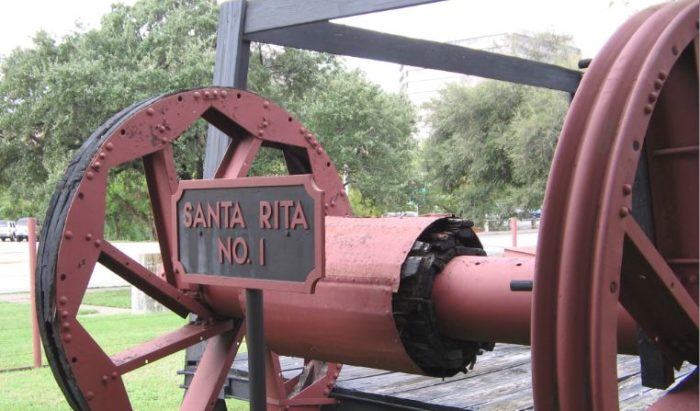
A 2007 University of Texas exhibit featured original Santa Rita cable-tool drilling equipment at San Jacinto Boulevard and 19th Street on the Austin campus. Photo by Bruce Wells.
Pickrell hired an experienced Pennsylvania driller, Carl Cromwell, to drill Texon Oil and Land’s test well. Cromwell had been born in 1889 not far from the first commercial U.S. oil well in Titusville, Pennsylvania.
Nuns and Roses
At the time, West Texas drilling crews, when available, “consisted mostly of cowboy roustabouts who were distinguished for high absenteeism and steady turnover,” notes one historian. The well often needed to be shut down because of a lack of cash to pay salaries or buy supplies.

Several months after the start of drilling, an increasingly concerned Pickrell climbed the derrick. At the top, he threw handfuls of rose petals that a group of Catholic women investors from New York had given him.
Pickrell christened his wildcat well for the church’s Patroness of Impossible Causes — Santa Rita. On May 25, 1923, early signs of oil and natural gas appeared. Three days later, Santa Rita No. 1 roared in as a West Texas gusher.
People as far away as Fort Worth traveled to see the well. Much-needed casing and other well equipment arrived a month later to bring the wild well under control, and the first commercial well in the Permian Basin went into production.

The Big Lake field — at 4.5 square miles — revealed that vast oil reserves in West Texas came from both shallow and deep formations. Exploration spread into other areas of the Permian Basin, still one of the largest oil-producing regions in the United States.
In the fall of 1923, Pickrell found an important investor, Michael L. Benedum, the highly successful independent oilman from Pittsburgh, Pennsylvania. Benedum and another Pittsburgh wildcatter, Joseph Trees, purchased Texon properties and formed the Big Lake Oil Company in 1924.
Big Lake Oilfield
The new company’s president, Levi Smith, would be instrumental in creating Big Lake — the first oil company town in the Permian Basin. Santa Rita No. 1 well, capped in May 1990, would be remembered with a replica erected in Reagan County Park.
The Big Lake oilfield proved to be 4.5 square miles and demonstrated that vast oil reserves in West Texas came from both shallow and deep horizons. Exploration spread into other areas of the Permian Basin, which would become one of the largest oil-producing regions in the United States.

Learn the story of the Permian Basin at the Petroleum Museum in Midland. Not far from the museum, in Odessa, an Ector County historical marker notes “the first Permian Basin dry hole” drilled in 1924.
Pennsylvania independent operators drilled the well to 900 feet and found only “Red Bed” rock, notes the 1965 marker. The 1924 well would be abandoned, but by 1964 Ector County would have 9,600 oil wells.
Hollywood at Big Lake
The 2002 movie “The Rookie” was filmed almost entirely in West Texas. It featured a Big Lake high-school teacher played by Dennis Quaid, who despite being in his mid-30s briefly makes it to the major leagues.

The opening scenes of the 2002 movie “The Rookie” included Catholic nuns christening the wildcat well with rose petals.
As the well is being drilled, Catholic nuns are shown carrying a basket of rose petals to christen it for the patron Saint of the Impossible – Santa Rita.
Learn more about baseball teams fielded by petroleum “company towns” in Oilfields of Dreams.
_______________________
Recommended Reading: Santa Rita: The University of Texas Oil Discovery (1958); Chronicles of an Oil Boom: Unlocking the Permian Basin
(1958); Chronicles of an Oil Boom: Unlocking the Permian Basin (2014). Your Amazon purchase benefits the American Oil & Gas Historical Society. As an Amazon Associate, AOGHS earns a commission from qualifying purchases.
(2014). Your Amazon purchase benefits the American Oil & Gas Historical Society. As an Amazon Associate, AOGHS earns a commission from qualifying purchases.
_______________________
The American Oil & Gas Historical Society (AOGHS) preserves U.S. petroleum history. Please become an AOGHS annual supporter and help maintain this energy education website and expand historical research. For more information, contact bawells@aoghs.org. © 2025 Bruce A. Wells.
Citation Information – Article Title: “Santa Rita taps Permian Basin.” Authors: B.A. Wells and K.L. Wells. Website Name: American Oil & Gas Historical Society. URL: https://aoghs.org/petroleum-pioneers/west-texas-petroleum. Last Updated: May 22, 2024. Original Published Date: November 1, 2004.
by Bruce Wells | May 13, 2025 | Petroleum Pioneers
The Ohio petroleum industry took off with an 1885 oilfield discovery in Allen County.
The “Great Oil Boom” of northwestern Ohio began when Benjamin C. Faurot, drilling for natural gas, found oil instead. His Ohio oil well of May 19, 1885, revealed the petroleum-rich Trenton Limestone at a depth of 1,252 feet.
“The oil find has caused much excitement and those who are working at the well have been compelled to build a high fence around it to keep curiosity seekers from bothering them,” Lima’s Daily Republican reported the next day.
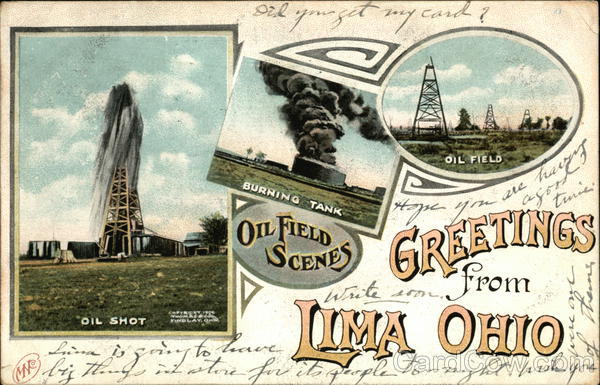
Postcards promoted the oil prosperity of Lima, Ohio, which began in 1885 with a well that found an oilfield while drilling for natural gas. Circa 1910 postcard published by Robbins Bros., Boston.
“If the well turns out, as it looks now that it will, look out for the biggest boom Lima ever had,” the newspaper proclaimed. The oil excitement rivaled the Trenton formation in Indiana (learn more in Indiana Natural Gas Boom).
In February 1885, looking for cheap energy for a paper mill he owned, Faurot had brought in cable-tool drillers from Pennsylvania to bore a natural gas well,” noted a 2019 article in the Lima News. His company, Lima Paper Mill, produced straw board and egg cases at its plant on the Ottawa River east of downtown.

After the oil discovery, Faurot organized the Trenton Rock Oil Company. Excited Lima citizens organized their own oil exploration venture, the Citizens’ Oil Company, which allowed only 100 investors with none allowed to hold more than five shares of stock sold at $20 per share.
The Faurot well had revealed the Lima oilfield — soon the largest oil producer in the world.

Cable-tool equipment with a wooden derrick and walking beam, once common sights in Allen County, Ohio. Circa 1910 postcard published by Thomas & Co., Findlay.
“In May of 1885, Lima was a bustling community of some 8,000 people with a new courthouse and, thanks to leading businessman Benjamin C. Faurot, an opera house. It claimed a soon-to-be-electrified city street car system, railroad connections in all directions and a handful of newspapers,” noted the Lima News.
“The great enterprise of piping oil from the Lima fields to Chicago manufacturing establishments is now, in this year of 1888, being undertaken by the Standard Oil Company, who practically control all the oil territory around Lima,” noted one reporter at the time.
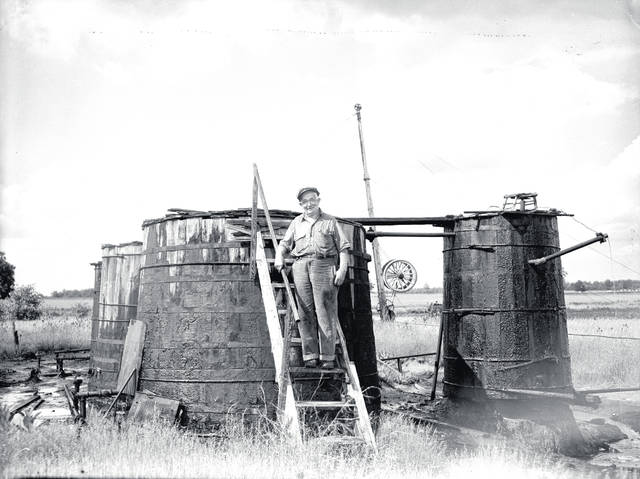
Wooden tanks (with a workover drilling rig in background) stored Lima oil before it was shipped to Cleveland refineries. Circa 1900 photo courtesy of Allen County Historical Society.
Among those attracted to Lima was the future four-time mayor of Toledo, Samuel Jones, who helped found the Ohio Oil Company (Marathon), patented an improved oil production technology, and became widely known as “Golden Rule” Jones of Ohio.

According to historian Richard Timberlake Jr., the “Panic of 1893” was a serious economic depression in the United States. Like a similar nationwide financial collapse two decades earlier, it was marked by the overbuilding of railroads, resulting in a series of bank failures.
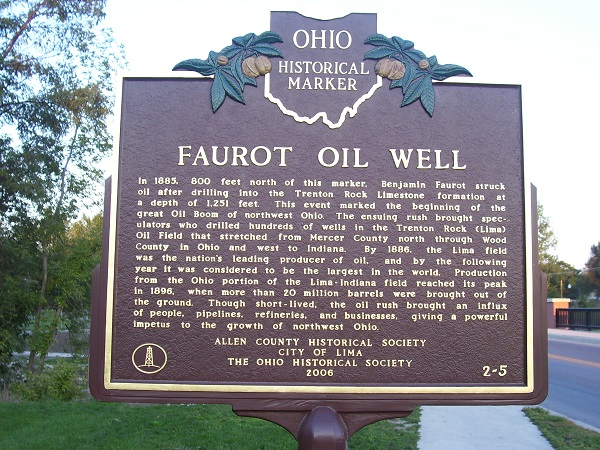
In 2006, the Ohio Historical Society dedicated a Faurot oil well marker at 835 East North Street in Lima.
By 1886, Lima was the most productive oilfield in America after producing more than 20 million barrels of oil. Much of the oil was “heavy” — thick and sulfurous — but by the following year Lima oilfields led the world in production.
Although short-lived, “the oil rush brought an influx of people, pipelines, refineries, and businesses, giving a powerful impetus to the growth of northwest Ohio,” concluded the Allen County Historical Society.
After developing a new method for refining the heavy Lima oil, Standard Oil Company of New Jersey began construction on its Whiting refinery in 1889.
The company used improved pipeline technologies to deliver refined Lima oil to the 1893 Columbian Exposition in Chicago. There, at 72.5 cents per barrel, Standard Oil fueled the world’s largest steam boiler installation at the time. Chicago’s fair ultimately attracted 27.5 million visitors.
Refining Sulfurous “Lima Oil”
An emigrant German chemist would bring Ohio oil riches to John D. Rockefeller. On February 21, 1887, Herman Frasch applied to patent a new process for eliminating sulfur from “skunk-bearing oils.”

Inventor and mining engineer Herman Frasch (1851-1914), the Standard Oil chemist later known as the “Sulfur King.”
The former employee of Standard Oil of New Jersey was quickly rehired. Rockefeller had acquired some of the Lima oilfields for bargain prices because the wells produced a thick, sulfurous oil. Despite its difficulty to refine, the petroleum tycoon had accumulated a 40-million-barrel stockpile of the cheap, sour “Lima oil.”
Standard Oil Company bought Frasch’s patent for a copper-oxide refining process to “sweeten” the oil. By the early 1890s, the company’s new Whiting oil refinery east of Chicago was producing odorless kerosene from desulfurized oil, making Rockefeller a fortune.

Paid in Standard Oil shares and becoming very wealthy, Frasch moved to Louisiana — where the skilled chemist and mining engineer invented a new method to extract sulfur from underground deposits by injecting superheated water into wells. By 1911, multimillionaire Frasch was known as the “Sulfur King.”
In 2006, the Allen County Historical Society placed an Ohio historical marker near Benjamin C. Faurot’s oilfield discovery well site at the North Street crossing of the Ottawa River in Lima.
Grand Lake St. Marys in Ohio — the largest man-made body of water in the world — supported commerce on the Erie Canal beginning in 1845. By the late 1880s, Mercer County was producing oil from wells pumping on platforms on the lake. Learn more in Ohio Offshore Oil wells.
_______________________
Recommended Reading: Ohio Oil and Gas (2008); Where it All Began: The story of the people and places where the oil & gas industry began: West Virginia and southeastern Ohio (1994); Herman Frasch -The Sulphur King (2013). Your Amazon purchase benefits the American Oil & Gas Historical Society. As an Amazon Associate, AOGHS earns a commission from qualifying purchases.
(1994); Herman Frasch -The Sulphur King (2013). Your Amazon purchase benefits the American Oil & Gas Historical Society. As an Amazon Associate, AOGHS earns a commission from qualifying purchases.
_______________________
The American Oil & Gas Historical Society (AOGHS) preserves U.S. petroleum history. Please become an annual AOGHS supporter and help maintain this energy education website and expand historical research. For more information, contact bawells@aoghs.org. Copyright © 2025 Bruce A. Wells.
Citation Information – Article Title: “Great Oil Boom of Lima Ohio.” Authors: B.A. Wells and K.L. Wells. Website Name: American Oil & Gas Historical Society. URL: https://aoghs.org/petroleum-pioneers/great-oil-boom-of-lima-ohio. Last Updated: May 14, 2025. Original Published Date: May 19, 2019.
by Bruce Wells | May 8, 2025 | Petroleum Pioneers
Pennsylvania drillers kept oil production from the 1882 Warren County well a closely guarded secret.
Every year in densely wooded Cherry Grove, Pennsylvania, community members celebrate a 19th-century oil well and its place in American petroleum history. Led by local and visiting oil patch historians in June 2024, the Cherry Grove Old Home and Community Day featured tours of the well that once shook global petroleum markets.
When daily oil production from the “Mystery Well” was revealed in 1882, oil prices plunged worldwide. The discovery well drilled on lot 646 in the wilderness of Warren County had been a closely guarded secret. (more…)
by Bruce Wells | Apr 18, 2025 | Petroleum Pioneers
Friendship monument dedicated in 1926 preserves the history of Osage oil leases.
Colonel Elmer Ellsworth (his real name) Walters was the most famous auctioneer in all of Oklahoma history. In 1912, the Osage Indians hired him to auction mineral rights from their petroleum-rich reservation. By 1920, they had awarded him a gold medal for his skillful sales of Osage oil leases.
Walters was paid $10 a day while earning the tribe millions of dollars while working beneath a giant elm tree in Pawhuska. In April 1926, his Osage friends and residents dedicated a “Bond of Friendship” monument in Walters’ nearby hometown of Skedee.
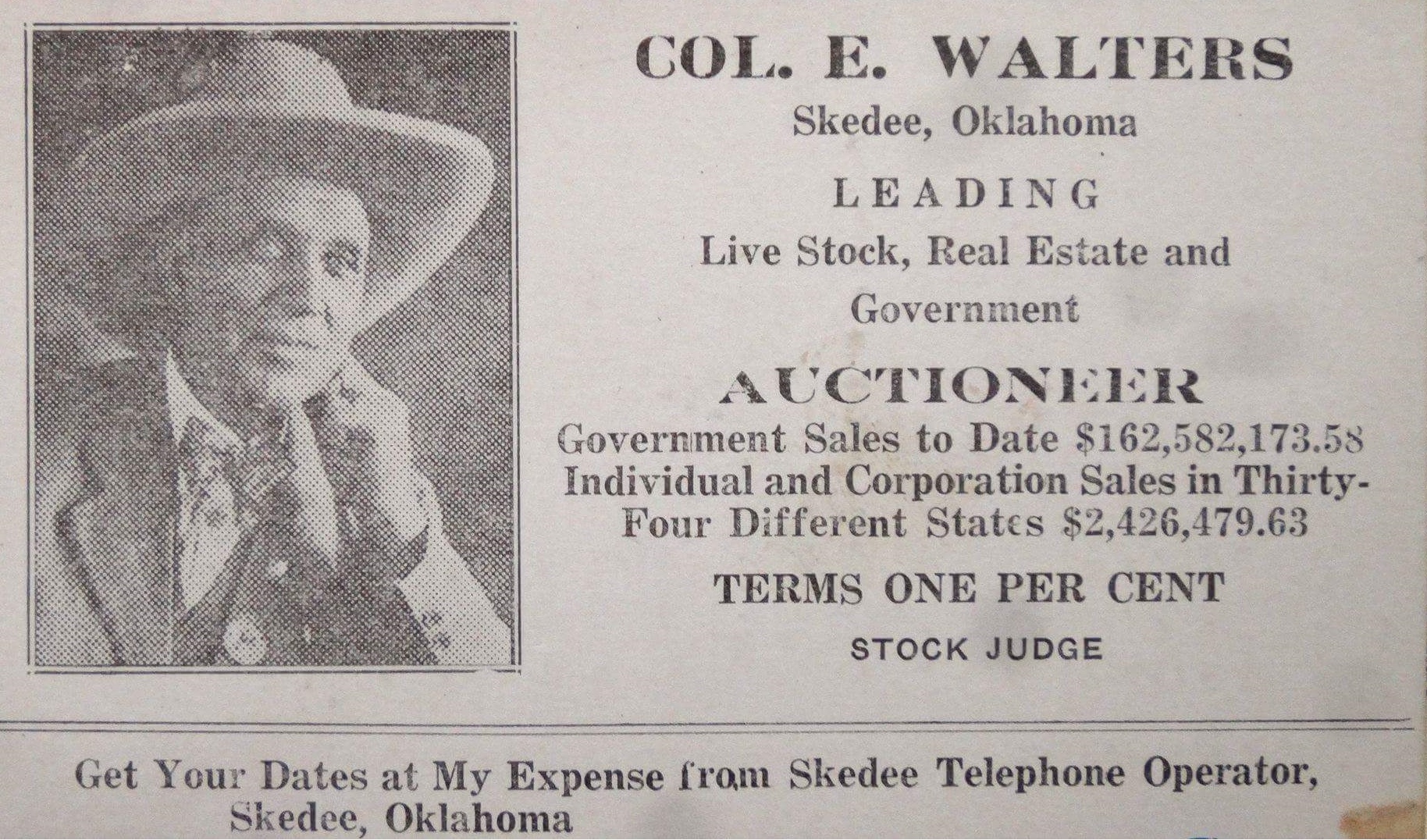
Newspaper ad courtesy of Colonel Walters’ great-great-granddaughter Hope Litvinoff. Her grandmother in 1926 helped unveil a statue in Skedee, Oklahoma, honoring Walters and the chief of the Osage Nation.
Born in Adrian, Illinois, in 1865, Walters was one year old when his parents moved to the Cherokee Nation, Indian Territory. He was named in honor of Col. Elmer Ephraim Ellsworth of the 11th New York Volunteers — the first Union officer killed at the start of the Civil War (shot while removing the Confederate flag from the roof of a hotel in Alexandria, Virginia).
Although Walters became a deputy U.S. marshal at 19, he began gaining distinction as an auctioneer. He sold livestock, real estate and mineral leases in 2,250-square-mile Osage County.
Million Dollar Elm
Beginning in 1912, Walters sold Osage mineral leases in 160-acre blocks based on “headrights” from a 1906 tribal population count. In Pawhuska, between the Osage council house and the county courthouse, Walters called the auctions while standing in the shade of what became known as the “Million Dollar Elm.”
The bidders for the leases were a who’s who of leading Oklahoma independent producers. E.W. Marland biographer John J. Mathews quotes one impressed onlooker: “You could stand on the edge of the crowd and see two or three of the biggest names in America squatting there on the grass, as common as an old shoe, and when they raised their hands it meant millions. That’s a fact!”

Another onlooker described hundreds of spectators and reporters who gathered to watch the bidding. Walters proved so effective at “extracting millions from the silk pockets of such newly minted oil barons as Frank Phillips, E.W. Marland, and William G. Skelly” that the Osages awarded him a medal.
“On February 3, 1920, before that day’s bidding began, the Osage tribe presented Walters with a medal to show their appreciation for all the wealth he’d drummed up for them in the shade of the Million Dollar Elm,” the witness reported.

Born in 1865, Colonel E.E. Walters wasn’t actually a Colonel. He was named in honor of the first Union officer killed in the Civil War, complete with rank. Currier and Ives engraving, 1861. Image courtesy Library of Congress.
By 1922, the National Petroleum News proclaimed that Walters had “Sold 10 Times As Much Property Under Hammer As Any Other Man” and his friends, the Osage, became “the richest people in the world.”
Beneath the Pawhuska elm on March 18, 1924, Walters secured a bid of $1,995,000 for one 160-acre tract. It was the highest price paid at that time, according to the Oklahoma Historical Society. Walters reportedly received more Osage gifts, including a diamond-studded badge and a diamond ring for his auctions of Osage oil leases.
Dark Side of Headrights
Sudden great wealth for the Osage people brought a bloody criminal conspiracy of unsolved murders that left dozens of Osage men, women, and children dead — killed for the headrights to their land.

In the early 1920s, Colonel E.E. Walters stood in the shade of a soon-famous Elm tree to auction mineral leases, including a $2 million bid for a single 160-acre Osage lease. Detail from a photo in Oil! Titan of the Southwest by Carl Coke Rister, 1949.
“Osage mineral leases earned royalties that were paid to the tribe as a whole, with each allottee receiving one equal share, or headright, of the payments, noted Oklahoma Historical Society historian Jon D. May in Osage Murders.
“A headright was hereditary and passed to a deceased allottee’s immediate legal heir,” May added. “One did not have to be an Osage to inherit an Osage headright.”
Estimates vary, but at least 24 Osage Indians died violent or suspicious deaths during the early 1920s, when con men, bootleggers and murderers began a “Reign of Terror.”

William K. Hale was one of the worst. He was accused of repeatedly orchestrating murders, tried four times, and finally convicted of a single killing. The best-seller 2018 book Killers of the Flower Moon by journalist David Grann investigated the disturbing and tragic stories.
The New Yorker staff writer’s award-winning book would be adapted into a $200 million movie directed by Martin Scorsese, who acquired book rights in July 2017.
Sadly, at the time most Oklahoma news media ignored the reservation’s murders — and the murderers. Newspapers there and around the country instead featured scandalous stories of incredible Osage wealth squandered on Pierce-Arrows and gaudy fashion. As Osage Indians died, reporters mocked the tribe with sarcasm and caricatures.
In his 1994 book, Bloodland: A Family Story of Oil, Greed and Murder on the Osage Reservation, Washington Post journalist Dennis McAuliffe noted little wonder that, “this period in our history hardly dances with awareness.”

On April 22, 1926, hundreds gathered in Skedee, Oklahoma, for the unveiling of the 25-foot Bond of Friendship monument honoring the chief of the Osage Nation and the state’s greatest auctioneer of mineral rights.
As a result of the Osage murders, on February 27, 1925, the U.S. Congress passed the “Osage Indians Act of 1925,” a law prohibiting non-Osages from inheriting headrights of tribal members possessing more than one-half of Osage blood.
According to the Osage Nation, in 2022, “approximately 26 percent of all headrights are owned by non-Osage individuals, churches, universities, and other non-Osage institutions who can freely bequeath such interests to any person or entity the non-Osage chooses.
Bond of Friendship
On April 22, 1926, hundreds gathered in Walter’s longtime home of Skedee for the dedication of a 25-foot Bond of Friendship monument. The unveiling revealed “painted bronze” statues of Walters and the chief of the Osage Nation shaking hands on a two-tiered sandstone and concrete base.
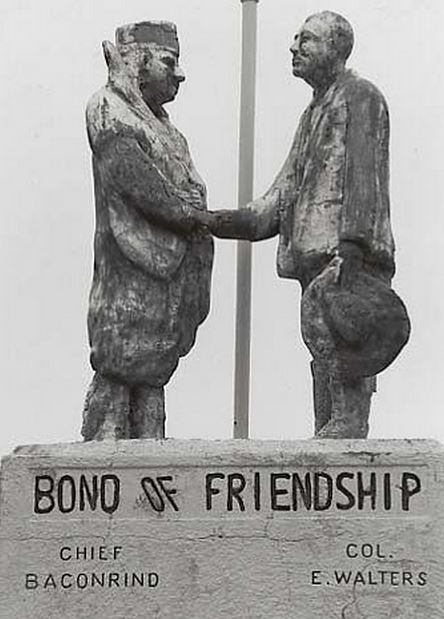
Like the town, the Bond of Friendship of Skedee, Oklahoma, has deteriorated since 1926. Photo courtesy the Library of Congress.
The friendship between Osage Chief (phonetically) Wah-she-hah and Walters left a statue in the Skedee town square. Wah-she-hah translates to Star-That-Travels in the Osage language — but history and visitors to the Skedee statue remember him as Chief Bacon Rind.
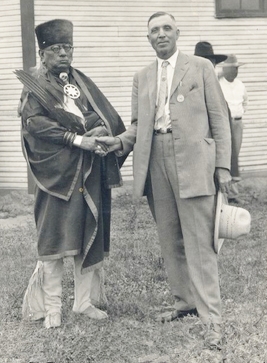
Osage Chief Bacon Rind and Colonel E.E. Walters in an undated photo.
Still standing in Skedee, the 1926 sculpture depicts Osage Chief Bacon Rind wearing his traditional otter-skin cap and a cloak. Walters wears a suit with trousers tucked into his boots and holds a hat in his left hand. At the statue’s unveiling, the popular “auctioneer of the Osage Nation” had sold $157 million in lease sales for his friends. But it wasn’t all good news.

By the early 2020s, the Skedee Bond of Friendship monument began showing its age. The legacy of the once famous lease auctioneer and the Osage friendship provided some merriment for at least one contributor to Roadside America:
“The lesson imparted here is that white and red can be harmonious — if you just add a little green…Atop a blocky concrete pillar stands the Chief and the Colonel, facing each other, shaking hands. The work is primitive for such well-oiled honorees…while the Chief and the Colonel appear to be made of Play-Doh spray-painted silver.”

Although a traditionalist in customs, Chief Bacon Rind’s leadership earned his people millions from oil and natural gas resources.
However, the Osage Chief Bacon Rind, “a statuesque man at six feet four inches,” at one time was among the most photographed of all Native Americans. The Works Progress Administration noted the chief frequently posed for the prominent artists of the day “and created an image of the romantic ideal of the American Indian.”
Chief Bacon Rind died in 1932 and Walters followed in 1946. The population of Skedee peaked in 1910; a century later fewer than 50 residents remained. The tall but weathered monument remains in the center of town.
Walters, an amateur poet, had his hopes for the future carved into his hometown monument’s base:
…I will build for them a landmark,
That the coming race may see,
All the beauties of the friendship,
That exists ‘tween them and me…
And explain it to grandchildren,
as they sit upon their knee.
Preserving Osage Oil Stories
In 2018, an Osage writer decided to look deeper into Walter’s life and times. Already an author of several books about Osage history, Anna Marie Jefferson a year later published Colonel E. Walters: Auctioneer for the Osage Lease Sales During the early 20th-Century. Her research revealed many local newspaper accounts and rare images from his career.

Osage writer Anna Marie Jefferson published her book about Colonel Walters in 2019.
Jefferson, who grew up in Osage County, remembered visiting the statue as a child in neighboring Pawnee County. “As an Osage (Sac and Fox/Pawnee as well) I was unaware of who Colonel E. Walters was, the man on top of the memorial.”

Familiar with Osage leader Bacon Rind, Jefferson began researching the life of Walters and his famed long career as a skilled auctioneer.
“When traveling the Osage, sometimes one needs to go just beyond the county lines to find early Osage Nation,” she explained in her book’s introduction. “Such is the case with the Bond of Friendship monument in the small town of Skedee, Oklahoma.”
_______________________
Recommended Reading: The Underground Reservation: Osage Oil (1985); Killers of the Flower Moon: The Osage Murders and the Birth of the FBI
(1985); Killers of the Flower Moon: The Osage Murders and the Birth of the FBI (2018); Colonel E. Walters: Auctioneer for the Osage Lease Sales During the early 20th-Century (2019). Your Amazon purchase benefits the American Oil & Gas Historical Society. As an Amazon Associate, AOGHS earns a commission from qualifying purchases.
(2018); Colonel E. Walters: Auctioneer for the Osage Lease Sales During the early 20th-Century (2019). Your Amazon purchase benefits the American Oil & Gas Historical Society. As an Amazon Associate, AOGHS earns a commission from qualifying purchases.
_______________________
The American Oil & Gas Historical Society (AOGHS) preserves U.S. petroleum history. Please become an AOGHS annual supporter and help maintain this energy education website and expand historical research. For more information, contact bawells@aoghs.org. © 2025 Bruce A. Wells.
Citation Information – Article Title: “Million Dollar Auctioneer.” Authors: B.A. Wells and K.L. Wells. Website Name: American Oil & Gas Historical Society. URL: https://aoghs.org/petroleum-pioneers/million-dollar-auctioneer. Last Updated: April 18, 2025. Original Published Date: March 27, 2015.
by Bruce Wells | Apr 11, 2025 | Petroleum Pioneers
Onlookers gathered for the 1897 “shooting” of the Nellie Johnstone oil well at Bartlesville in Indian Territory.
After securing rights to explore in the Cherokee Nation, a small group of businessmen drilled on the west bank of the Caney River and found oil on March 25, 1897, at a depth of about 1,300 feet. A few weeks later, Bartlesville residents gathered at the site to watch the “shooting” of the Nellie Johnstone No. 1, the future state of Oklahoma’s first commercial oil well.
Soon after the Civil War, America’s search for oil to refine into kerosene for lamps prompted entrepreneurs, speculators, and the new petroleum industry’s “wildcatters” to seek their fortunes on the great plains of the Indian Territory.
(more…)

























